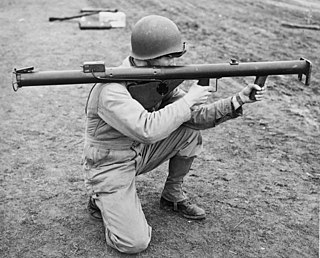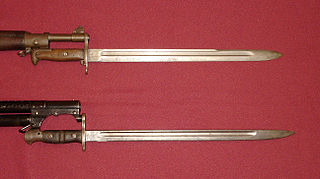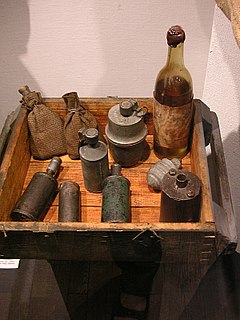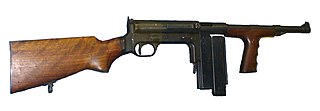 W
WBazooka (/bəˈzuːkə/) is the common name for a man-portable recoilless anti-tank rocket launcher weapon, widely deployed by the United States Army, especially during World War II. Also referred to as the "Stovepipe", the innovative bazooka was among the first generation of rocket-propelled anti-tank weapons used in infantry combat. Featuring a solid-propellant rocket for propulsion, it allowed for high-explosive anti-tank (HEAT) warheads to be delivered against armored vehicles, machine gun nests, and fortified bunkers at ranges beyond that of a standard thrown grenade or mine. The universally-applied nickname arose from the M1 variant's vague resemblance to the musical instrument called a "bazooka" invented and popularized by 1930s U.S. comedian Bob Burns.
 W
WThe BEANO T-13 hand grenade was an experimental Hand Grenade developed by the Office of Strategic Services, with assistance from Eastman Kodak Corporation, in the latter years of World War II.
 W
WKa-Bar is the contemporary popular name for the combat knife first adopted by the United States Marine Corps in November 1942 as the 1219C2 combat knife, and subsequently adopted by the United States Navy as the U.S. Navy utility knife, Mark 2. Additionally, Ka-Bar is the name of a related knife manufacturing company, Ka-Bar Knives., Inc., of Olean, New York, a subsidiary of the Cutco Corporation.
 W
WThe M1 and M1A1 were portable flamethrowers developed by the United States during World War II. The M1 weighed 72 lb, had a range of 15 meters, and had a fuel tank capacity of five gallons. The improved M1A1 weighed less, at 65 lb, had a much longer range of 45 meters, had the same fuel tank capacity, and fired thickened fuel (napalm).
 W
WThe M1 grenade projection adapter was an expedient rifle grenade used by the American military in World War II, Korea, and Vietnam. It consisted of an add-on 22 mm stabilizer tube and fins that converted a hand-grenade into a rifle grenade. It supplanted the M17 rifle grenade, and was eventually made obsolete by the 40 mm M79 grenade launcher.
 W
WThe M1, M1A1 and M4 are circular steel cased United States anti-tank blast mines with a distinctive cross shaped pressure spider. The mine was used during the Second World War and a copy produced in Argentina was used during the Falklands War. Another copy is produced in China. designated the No. 4 mine. Variants of the mine have also been deployed in Chad and Tunisia.
 W
WThe M1 mortar is an American 81 millimeter caliber mortar. It was based on the French Brandt mortar. The M1 mortar was used from before World War II until the 1950s when it was replaced by the lighter and longer ranged M29 mortar.
 W
WThe M2 4.2-inch mortar was a U.S. rifled 4.2-inch (107 mm) mortar used during the Second World War and the Korean War. It entered service in 1943. It was nicknamed the "Goon Gun" or the "Four-Deuce". In 1951 it began to be phased out in favor of the M30 mortar of the same caliber.
 W
WThe M2 machine gun or Browning .50 caliber machine gun is a heavy machine gun designed toward the end of World War I by John Browning. Its design is similar to Browning's earlier M1919 Browning machine gun, which was chambered for the .30-06 cartridge. The M2 uses the much larger and much more powerful .50 BMG cartridge, which was developed alongside and takes its name from the gun itself. It has been referred to as "Ma Deuce", in reference to its M2 nomenclature. The design has had many specific designations; the official US military designation for the current infantry type is Browning Machine Gun, Cal. .50, M2, HB, Flexible. It is effective against infantry, unarmored or lightly armored vehicles and boats, light fortifications, and low-flying aircraft.
 W
WThe M2 flamethrower was an American, man-portable, backpack flamethrower that was used in World War II, the Korean War, and the Vietnam War. The M2 was the successor to the M1 and M1A1 flamethrowers. Although its burn time was only around 7 seconds, and the flame was only effective out to around 20–40 meters, it was still a useful weapon. With the arrival of flamethrower tanks, the need for flamethrower-carrying infantrymen to expose themselves to enemy fire had been greatly reduced.
 W
WThe Hyde-Inland M2 was a United States submachine gun design submitted for trials at Aberdeen Proving Ground in February 1941. Work was undertaken by General Motors Inland Manufacturing Division to develop workable prototypes of George Hyde's design patented in 1935. The model first submitted for trials in April 1942 was designated the Hyde-Inland 1. Trials revealed the design was superior to the M1 submachine gun in mud and dirt tests, and its accuracy in full-automatic firing was better than any other submachine gun tested at the time. An improved Hyde-Inland 2 was designated U.S. Submachine gun, Caliber .45, M2 as a substitute standard for the M1 Thompson in April 1942. As Inland's manufacturing capacity became focused on M1 carbine production, the US Army contracted M2 production to Marlin Firearms in July 1942. Marlin began production in May 1943. Marlin's production failed to match the trials prototype performance; and Marlin's original contract for 164,450 M2s was canceled in 1943 upon adoption of the M3 submachine gun. The M2 is chambered for the .45 ACP cartridge and used the same 20- or 30-round magazine as the Thompson. Its cyclic rate of fire is 570 rounds per minute. None of the approximately 400 manufactured were issued by any branches of the United States military.
 W
WThe M2 Mortar is a 60 millimeter smoothbore, muzzle-loading, high-angle-of-fire weapon used by U.S. forces in World War II, the Korean War, and the Vietnam War for light infantry support.
 W
WThe M3 fighting knife or M3 trench knife was an American military combat knife first issued in March 1943. The M3 was originally designated for issue to soldiers not otherwise equipped with a bayonet. However, it was particularly designed for use by forces in need of a close combat knife, such as Airbornes and Army Rangers, so these units received priority for the M3 at the start of production. As more M3 knives became available in 1943 and 1944, the knife was issued to other soldiers such as Army Air Corps crewmen and soldiers not otherwise equipped with a bayonet, including soldiers issued the M1 Carbine or submachine gun.
 W
WThe M4 bayonet was introduced in 1944 for use with the M1 carbine. It was built on the M3 fighting knife.
 W
WThe M7 grenade launcher, formally rifle grenade launcher, M7, was a 22 mm rifle grenade launcher attachment for the M1 Garand rifle that saw widespread use throughout World War II and the Korean War. The M7 was a tube-shaped device, with one end slotting over the muzzle of the rifle and attaching to the bayonet mount, and the other end holding the grenade in place. Blank cartridges were loaded into the rifle prior to firing. When fired, the expanding gases generated by the cartridges propelled the grenade forward with considerable force. The M7 could fire grenades up to 200 metres, compared with the maximum of 30 metres achieved by a hand-thrown grenade.
 W
WThe M9 rifle grenade was a U S anti-tank rifle grenade used during World War II. It was derived as a lighter version of the M10 grenade which was too heavy to be fired to an effective distance from a rifle.
 W
WThe M17 is a rifle grenade that was used by the United States during World War II.
 W
WThe M18 recoilless rifle is a 57 mm shoulder-fired, anti-tank recoilless rifle that was used by the U.S. Army in World War II and the Korean War. Recoilless rifles are capable of firing artillery-type shells at reduced velocities comparable to those of standard cannon, but with greater accuracy than anti-tank weapons that used unguided rockets, and almost entirely without recoil. The M18 was a breech-loaded, single-shot, man-portable, crew-served weapon. It could be used in both anti-tank and anti-personnel roles. The weapon could be both shoulder fired or fired from a prone position. The T3 front grip doubled as an adjustable monopod and the two-piece padded T3 shoulder cradle could swing down and to the rear as a bipod for the gunner. The most stable firing position was from the tripod developed for the water-cooled Browning M1917 machine gun.
 W
WThe M20 recoilless rifle is a U.S. 75 mm caliber recoilless rifle T21E12 that was used during the last months of the Second World War and extensively during the Korean War. It could be fired from an M1917A1 .30 caliber machine gun tripod, or from a vehicle mount, typically a Jeep. Its shaped charge warhead, also known as HEAT, was capable of penetrating 100 mm of armor. Although the weapon proved ineffective against the T-34 tank during the Korean War and most other tanks, it was used primarily as a close infantry support weapon to engage all types of targets including infantry and lightly armored vehicles. The M20 proved useful against pillboxes and other types of field fortifications. Its poor armor penetration by the HEAT round was because of it being a spin-stabilized projectile rather than the later fin-stabilized rounds used in the 106mm M40 recoilless rifle.
 W
WThe Model of 1905 bayonet was made for the U.S. M1903 Springfield rifle. This designation was changed to Model 1905 in 1917, and then to M1905 in 1925, when the army adopted the M designation nomenclature. The M1905 bayonet has a 16-inch (40.6 cm) steel blade and a 4-inch (10.16 cm) handle with wooden or plastic grips. The bayonet also fits the U.S. M1 Garand rifle. From 1943 to 1945, a shorter, 10-inch (25.4 cm), bladed version was produced with black or dark red molded plastic grips, and designated the M1 bayonet. A number of M1905 bayonets were recalled from service, their blades cut down, and reissued as M1 bayonets.
 W
WThe M1911, also known as the Colt 1911, or the Colt Government, is a single-action, semi-automatic, magazine-fed, recoil-operated pistol chambered for the .45 ACP cartridge. The pistol's formal designation as of 1940 was Automatic Pistol, Caliber .45, M1911 for the original model of 1911 or Automatic Pistol, Caliber .45, M1911A1 for the M1911A1, which was adopted in 1924. The designation changed to Pistol, Caliber .45, Automatic, M1911A1 in the Vietnam War era.
 W
WThe M1917 bayonet was designed to be used with the US M1917 Enfield .30 caliber rifle, as well as with the seven different U.S. trench shotguns. The blade was 17 inches (43.2 cm) long. It will not fit the M1903 .30 caliber (Springfield) or the M1 .30 caliber (Garand) US service rifles as they have different bayonet ring (barrel) and attachment stud dimensions.
 W
WThe Browning Automatic Rifle is a family of American automatic rifles and machine guns used by the United States and numerous other countries during the 20th century. The primary variant of the BAR series was the M1918, chambered for the .30-06 Springfield rifle cartridge and designed by John Browning in 1917 for the American Expeditionary Forces in Europe as a replacement for the French-made Chauchat and M1909 Benét–Mercié machine guns that US forces had previously been issued.
 W
WThe Mark I trench knife is an American trench knife designed by officers of the American Expeditionary Force (AEF) for use in World War I. It has a 6.75 in (17.1 cm) double-edged dagger blade useful for both thrusting and slashing strokes, unlike previous U.S. trench knives such as the M1917 and M1918. The handle is made of cast bronze and uses a conical steel nut to hold the blade in place. The Mark I's blade was blued with a black oxide finish, the bronze handle was chemically blackened, with cast spikes on the bow of each knuckle. The spikes were intended to prevent an opponent from grabbing the knife hand, as well as to provide a more concentrated striking surface when employed in hand-to-hand combat.
 W
WThe Mk 2 grenade is a fragmentation type anti-personnel hand grenade introduced by the U.S. armed forces in 1918. It was the standard issue anti-personnel grenade used during World War II, and also saw limited service in later conflicts, including the Korean War and Vietnam War. Replacing the failed Mk 1 grenade of 1917, it was standardized in 1920 as the Mk II, and redesignated the Mk 2 on April 2, 1945.
 W
WThe MK3 offensive hand grenade is a cylindrical concussion grenade designed to produce casualties during close combat while minimizing danger to friendly personnel exposed in the open owing to minimal fragmentation. There is a secondary fragmentation hazard though from rocks, gravel, wood splinters, glass, etc. The grenade is also used for concussion effects in enclosed areas, for blasting, or for demolition tasks. The shock waves (overpressure) produced by this grenade when used in enclosed areas are greater than those produced by the fragmentation grenade. It is, therefore, very effective against enemy soldiers located in bunkers, buildings, and fortified areas. It is commonly known as the "concussion" or "demo" grenade.
 W
WA satchel charge is a demolition device, primarily intended for combat, whose primary components are a charge of dynamite or a more potent explosive such as C-4 plastic explosive, a carrying device functionally similar to a satchel or messenger bag, and a triggering mechanism; the term covers both improvised and formally designed devices.
 W
WThe Smith & Wesson Model 10, previously known as the Smith & Wesson .38 Hand Ejector Model of 1899, the Smith & Wesson Military & Police or the Smith & Wesson Victory Model, is a K-frame revolver of worldwide popularity. In production since 1899, the Model 10 is a six-shot, .38 Special, double-action revolver with fixed sights. Over its long production run it has been available with barrel lengths of 2 in (51 mm), 2.5 in (64 mm), 3 in (76 mm), 4 in (100 mm), 5 in (130 mm), and 6 in (150 mm). Barrels of 2.5 inches (64 mm) are also known to have been made for special contracts. Some 6,000,000 of the type have been produced over the years, making it the most popular handgun of the 20th century.
 W
WThe United Defense M42, sometimes known as the Marlin for the company that did the actual manufacturing, was an American submachine gun used during World War II. It was produced from 1942 to 1943 by United Defense Supply Corp. for possible issue as a replacement for the Thompson submachine gun and was used by agents of the Office of Strategic Services (OSS). However, its usage was limited, and the Thompson continued to see service until the end of the war, alongside the M3 submachine gun, which was designed around the same time as the M42.